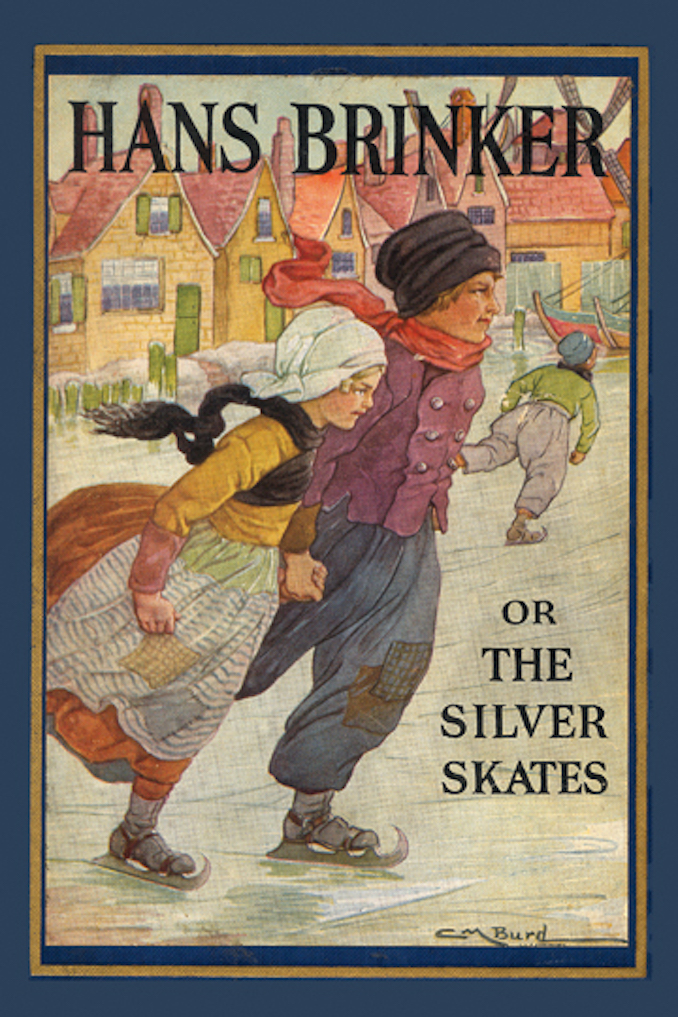
“But, lest you forget a tiny form trembling and sobbing on the mound before the Brinker cottage, ask the Van Glecks; they will never weary of telling of the darling little girl who won the silver skates.” ~ Mary Mapes Dodge
By Catherine Austin Fitts
My childhood summers were spent at my mother’s family farm in the White Mountains. Surrounded by national forest on three sides with a 180-degree view of the Presidential Mountains, and sporting a bountiful garden and several acres of blueberries, it was the perfect place for a child who loved to read.
Mornings were for tending the garden, picking blueberries, and hiking. Afternoons were often reserved for reading in one of the several hammocks that graced the trees surrounding the farmhouse.
The farmhouse second floor was made up of three children’s bedrooms. Each had an old wooden bookshelf filled with the classics read by many generations of the Willits family. Searching the shelves for my next book was like engaging in a treasure hunt through their beautiful but worn-out covers. The offerings included many of the Scribner classics with illustrations by N.C. Wyeth and Maxfield Parrish. There were also children’s books my grandparents acquired in their travels, including during a sabbatical in Switzerland.
There were copies of The Little Prince (Le Petit Prince), The Scottish Chiefs, Treasure Island, Rip Van Winkle, The Arabian Nights, Robin Hood, and King Arthur. There were scores of books on the magical world of animals and their friendship with mankind: Charlotte’s Web, Black Beauty, The Yearling, and Jack London’s Call of the Wild and White Fang. There was poetry from Shakespeare, Coleridge, Kipling, Dylan Thomas, Edna St. Vincent Millay, and Walt Whitman. Winning poetry contests with my grandfather required memorizing lots of lines.
The classic book about the Netherlands was Hans Brinker, or the Silver Skates, by Mary Mapes Dodge. This is the story of a brother and sister, Hans and Gretal Brinker—poor, industrious children who hope to compete in a speed skating race that has a prize of silver skates. This is also the source of the story about the little unnamed Dutch boy who saves his village by spending the night with his finger in the dike after it has sprung a leak. I cannot imagine an American child of my generation who would not have heard the story of the little Dutch boy.
In late winter this year, I woke up to the sound of hundreds of people skating on the canals in Stavoren. I rarely hear such joy in the air these days. I looked out of my window and saw that the canals and the port were filled with people skating and racing and twirling across the ice. It was a sight to behold. It looked just like the pictures in my childhood copy of Hans Brinker, or the Silver Skates. And so I commented to a friend that all of Stavoren looked like a scene from the book—indeed, now Holland was looking like the pictures I had been given in childhood.
To my amazement, no one that I know in the Netherlands has ever heard about Hans Brinker, or the Silver Skates (although everyone knew of the little Dutch boy, likely thanks to American ad agencies), and it turns out that virtually no one in the Netherlands has ever heard of the book. Then, I learned that an American wrote Hans Brinker, or the Silver Skates—an American who had never visited the Netherlands until after she wrote her book. So, I decided to take a break from current events and dive back into a childhood favorite by re-reading Hans Brinker, or the Silver Skates.
The story is set in the 19th century and apparently introduced the sport of Dutch speed skating to America. It gives children a sense of the long history of the Dutch relationship with the sea and water that comes from living in a country at or below sea level. A significant amount of the Netherlands land mass has been wrestled from the sea by the hardworking Dutch.
“Persons are born, live, and die, and even have their gardens on canal-boats. Farmhouses, with roofs like great slouched hats pulled over their eyes, stand on wooden legs with a tucked-up sort of air, as if to say, ‘We intend to keep dry if we can.’ Even the horses wear a wide stool on each hoof as if to lift them out of the mire. In short, the landscape everywhere suggests a paradise for ducks. It is a glorious country in summer for barefoot boys and girls.” – Mary Mapes Dodge
This is a great story in the old style to read to children about adversity and how children can overcome it. It is true that the Dutch people love to skate, but don’t expect them to know the story. Once again, another childhood assumption bites the dust!
Related reading:
